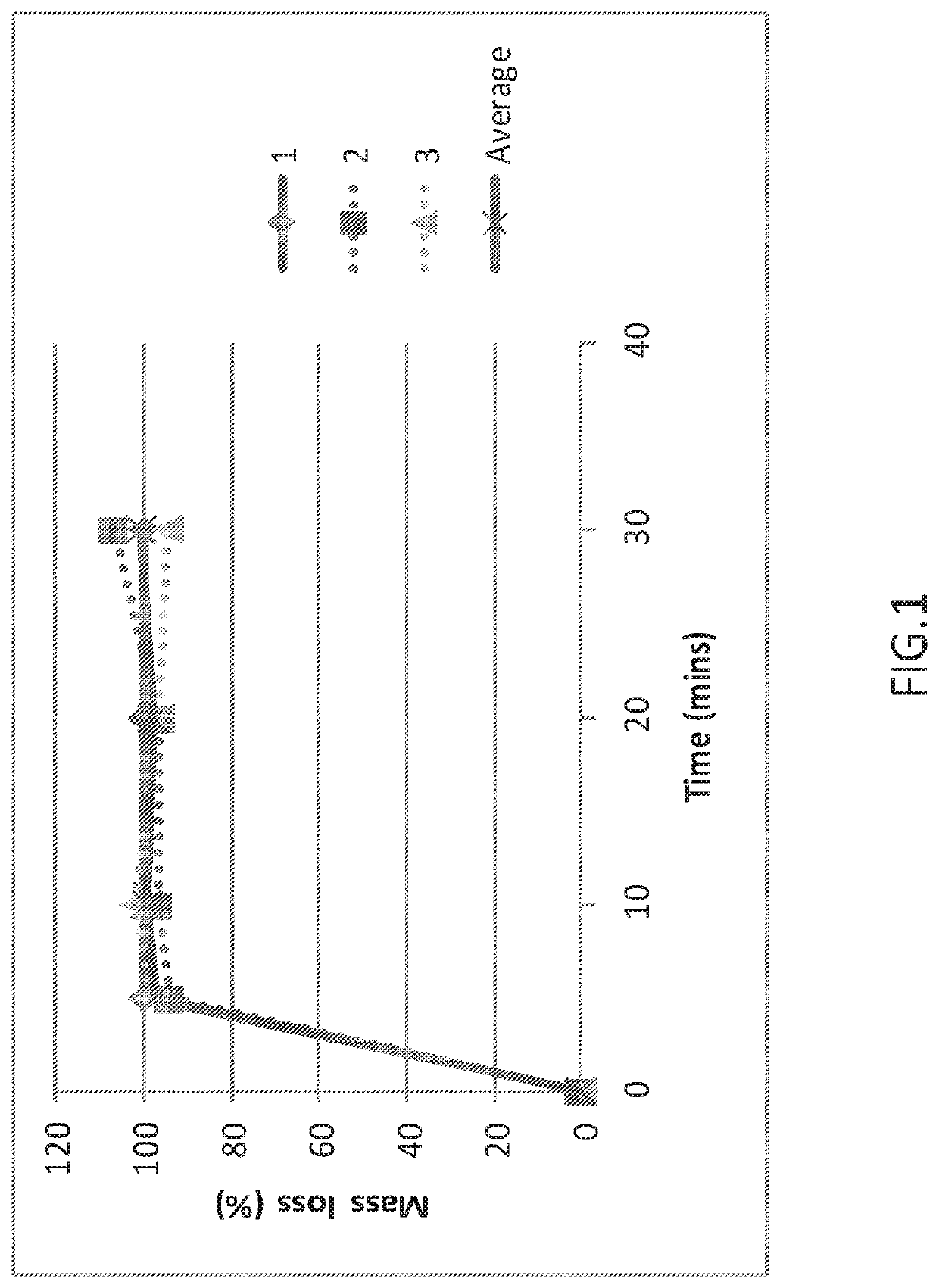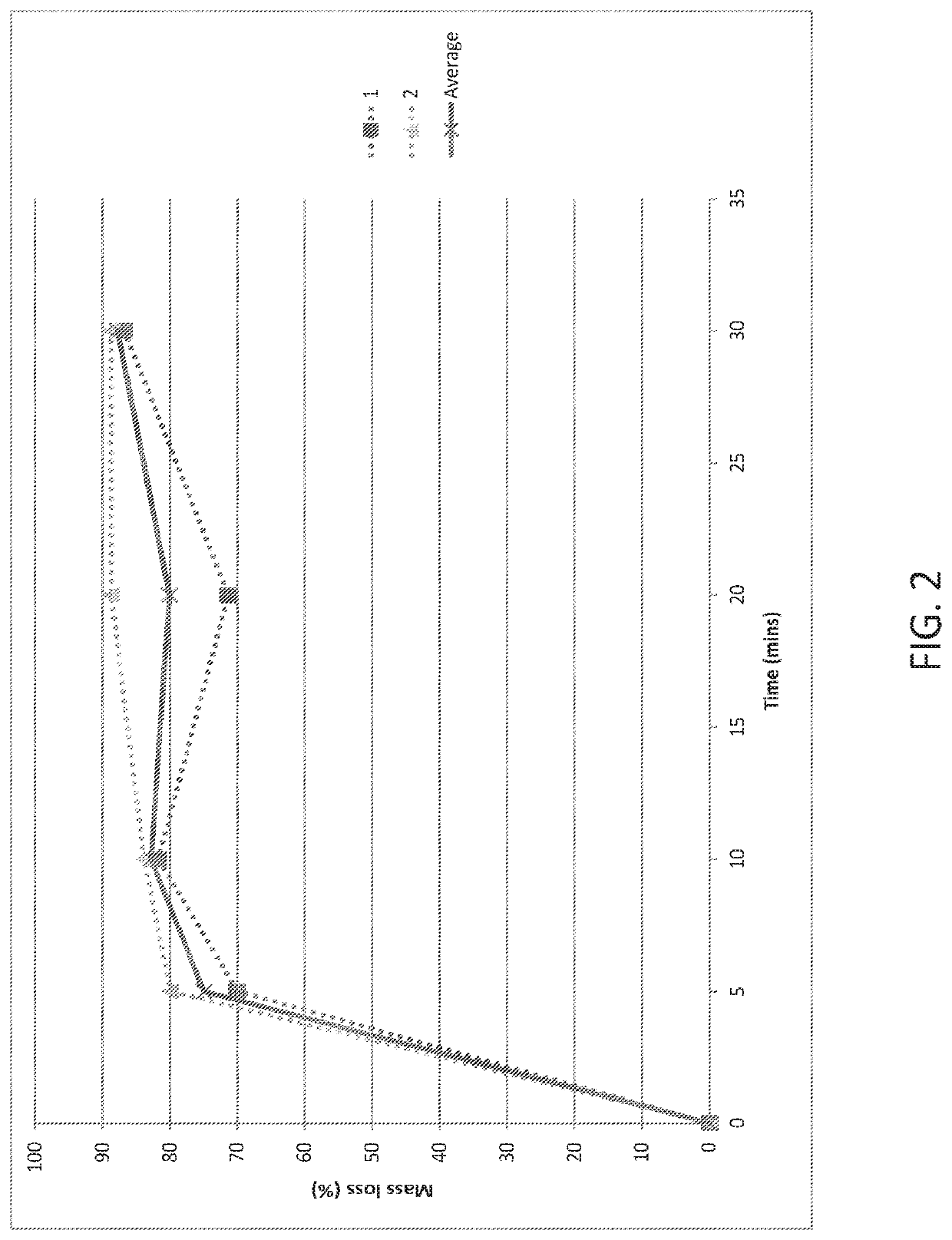Coated particles
a technology of coating particles and coatings, applied in the field of coating particles, can solve the problems of reducing the efficacy of drugs, affecting the safety of patients,
- Summary
- Abstract
- Description
- Claims
- Application Information
AI Technical Summary
Benefits of technology
Problems solved by technology
Method used
Image
Examples
example 1
RE OF PARTICLE FORMULATIONS
[0098]Formulations 1-2
[0099]Tetraethoxyorthosilane (TEOS) (3.50 kg, 16.80 moles) and hydrochloric acid (0.1 M solution in DI water, 840 mL, 83.95 mmoles) are added to a 10 L polypropylene beaker and stirred vigorously on a stirrer / hotplate. Oxycodone hydrochloride (252 g, 717.80 mmoles) is dissolved in deionised water (1579 mL) and then added to the TEOS / 0.1 M HCl mixture. The resulting biphasic mixture is covered and left to stir at room temperature (NB, the reaction is exothermic in the initial stages and the temperature of the solution rises to ˜60-65° C. before naturally cooling to room temperature). The reaction gels after ˜72 hours, at which point the gel is transferred to HDPE trays, spread out and dried in a venting oven at 60° C. for 48 hours.
[0100]The resulting solid sol-gel glass chunks are reduced in size using a FitzMill Comminutor to give ˜500 μm sized particles of the drug-loaded sol-gel carrier. This material is then placed back in the oven...
example 2
ON STUDIES
[0136]Aqueous solutions of the sodium phosphate and potassium silicate water-soluble glasses are first freeze-dried for 24 hours. The resulting solids are then milled and sieved to obtain glass powders of the size range 38-250 μm.
[0137]500 mg of the glass powder is added to 50 mL of the dissolution medium (pH 6.8 phosphate buffer or 40% EtOH / 0.1 M HCl) and stirred. At the following time points—5, 10, 20 and 30 minutes, a 10 mL aliquot is removed and filtered through a 0.45 μm PVDF syringe filter and analysed by ICP-OES analysis for sodium, potassium, silicon and phosphorus content as required. Simultaneously, the remaining solution (˜40 mL) is filtered through a fluted filter paper. Residual solids collected on the filter paper, and left in the reaction beaker, are dried thoroughly in the oven (typically 50-80° C. overnight) and weighed.
[0138]The results of the dissolution studies are provided in FIGS. 1-4. The results show that dissolution behaviour from the phosphate gla...
example 3
TUDIES
[0140]Standard conditions as specified by the United States Pharmacopoiea (USP) guidelines were followed, using a Distek USP I apparatus (basket dissolution tester).
[0141]900 mL of dissolution media (pH 6.8 phosphate buffer and 40% EtOH / 0.1 M HCl) was first de-gassed and then equilibrated to 37° C.±0.5° C. 200 mg of the formulation with the desired particle size distribution was added to 150 mesh baskets and submerged into the dissolution media and stirred at 100 rpm. At the necessary time points (every 15 minutes up to 2 hours for EtOH / HCl media and 0.5, 1, 1.5, 2, 3, 4, 6, 8, 10 and 12 hours for phosphate buffer) 9 mL of dissolution media was removed using a Distek autosampler and analysed for oxycodone content by UVNis spectroscopy. The results are provided in Tables 6-9 below, and in FIGS. 5-19.
TABLE 6Percentage oxycodone release in pH 6.8 phosphatebuffer for uncoated particles of varyingparticle size correlated with increasing timeTime (hours)Formulation0.511.523468101217...
PUM
| Property | Measurement | Unit |
|---|---|---|
| temperature | aaaaa | aaaaa |
| particle size | aaaaa | aaaaa |
| diameter | aaaaa | aaaaa |
Abstract
Description
Claims
Application Information
 Login to View More
Login to View More - R&D
- Intellectual Property
- Life Sciences
- Materials
- Tech Scout
- Unparalleled Data Quality
- Higher Quality Content
- 60% Fewer Hallucinations
Browse by: Latest US Patents, China's latest patents, Technical Efficacy Thesaurus, Application Domain, Technology Topic, Popular Technical Reports.
© 2025 PatSnap. All rights reserved.Legal|Privacy policy|Modern Slavery Act Transparency Statement|Sitemap|About US| Contact US: help@patsnap.com



